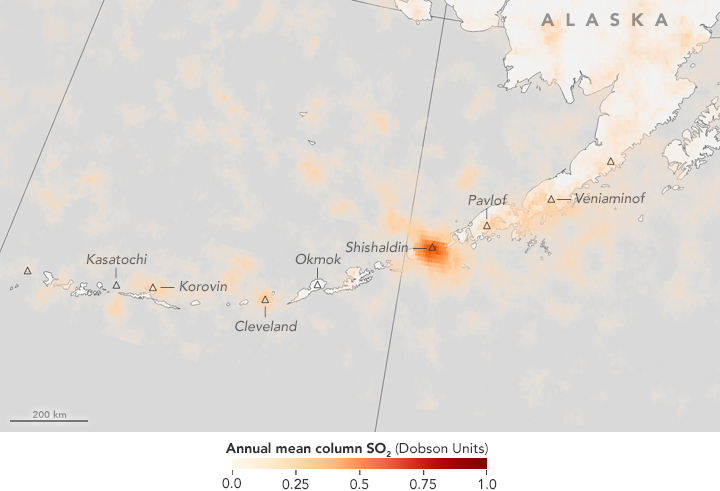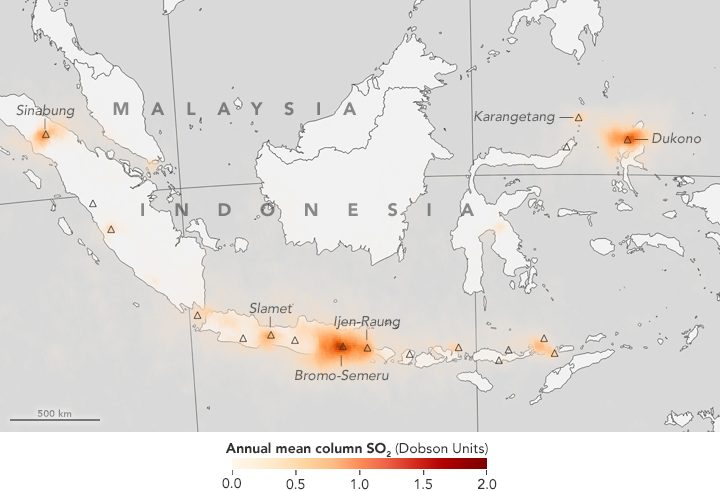


Volcanoes erupt, spewing ash and rock. Their scarred flanks sometimes run with both lava and landslides. Such eruptions are dramatic, but sporadic.
A less dramatic but important volcanic process is the continuous, mostly quiet emission of gas. A number of volcanoes around the world continuously exhale water vapor laced with heavy metals, carbon dioxide, hydrogen, sulfide and sulfur dioxide, among many other gases. Of these, sulfur dioxide is the easiest to detect from space.
In a new study published in Scientific Reports this week, a team of researchers reported on a new global inventory of sulfur dioxide emissions from volcanoes. They compiled emissions data gathered by the Dutch-Finnish Ozone Monitoring Instrument (OMI) on NASA’s Aura satellite, and then produced annual emissions estimates for 91 active volcanoes worldwide. The maps above and below depict the emissions from volcanoes in the Aleutian Island chain off Alaska and in the islands of Indonesia.
“Many people may not realize that volcanoes are continuously releasing quite large amounts of gas, and may do so for decades or even centuries,” said Michigan Technological University volcanologist Simon Carn, the lead author of the study. “Because the daily emissions are smaller than a big eruption, the effect of a single plume may not seem noticeable. But the cumulative effect of all volcanoes can be significant. In fact, on average, volcanoes release most of their gas when they are not erupting.”
Carn and his team found that volcanoes collectively emit 20 to 25 million tons of sulfur dioxide (SO2) into the atmosphere each year. This number is higher than the previous estimate (made from ground measurements in the 1990s) because the new research includes data on more volcanoes, including some that scientists have never visited.

The sulfur dioxide released by volcanoes is half as much as the amount released by human activities, according to co-author Vitali Fioletov, an atmospheric scientist at Environment and Climate Change Canada. He has been working with satellite observations and wind data to catalog SO2 emissions sources (human and volcanic) and trace them back to their sources.
Manmade emissions of sulfur dioxide have been declining in many countries due to stricter pollution and technological advances. As those emissions decrease, the relative importance of persistent volcanic emissions rises. These new data will help refine climate and atmospheric chemistry models and provide more insight into human and environmental health risks. Atmospheric processes convert SO2 into sulfate aerosols—small suspended particles in the atmosphere that reflect sunlight back into space and can cause a cooling effect on climate. Sulfate aerosols near the land surface are harmful to breathe. Higher in the atmosphere, they become the primary source of acid rain.
Tracking sulfur dioxide emissions via satellite also could help with eruption forecasting, as noticeable increases in SO2 gas releases may precede eruptions. “It is complementary to ground-based monitoring,” Carn said. “Ground-based measurements are crucial, but the satellite data could allow us to target new measurements at unmonitored volcanoes more effectively, leading to better estimates of volcanic carbon dioxide emissions.”
Field measurements of SO2 emissions are inproving, but they are still too sparse for a cohesive global picture. That’s where the new inventory is handy: it gathers data from remote volcanoes and provides consistent measurements over time from the world’s biggest emitters, including Ambrym in Vanuatu and Kilauea in Hawaii.
“Satellites provide us with a unique big-picture view of volcanic emissions that is difficult to obtain using other techniques,” Carn said. “We can use this to look at trends in sulfur dioxide emissions on the scale of an entire volcanic arc.”
NASA Earth Observatory maps created by Jesse Allen, using OMI data provided courtesy of Chris McLinden, Environment Canada. Caption by Allison Mills, Michigan Technological University; edited by Mike Carlowicz.